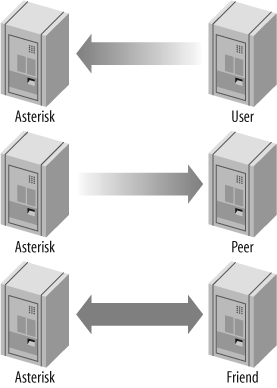It should come as no surprise that Asterisk loves to talk VoIP. But in order to do so, Asterisk needs to know which function it is to perform: that of client, server, or both. One of the most complex and often confusing concepts in Asterisk is the naming scheme of inbound and outbound authentication.
Connections that authenticate to us, or that we authenticate, are defined in the iax.conf and sip.conf files as users and peers. Connections that do both may be defined as friends. When determining which way the authentication is occurring, it is always important to view the direction of the channels from Asterisk’s viewpoint, as connections are being accepted and created by the Asterisk server.
A connection defined as a user is any system/user/endpoint that we allow to connect to
us. Keep in mind that a user
definition does not provide a method with which to call that user; the
user type is used simply to create
a channel for incoming calls.[117] A user definition
will require a context name to be defined to indicate where the
incoming authenticated call will enter the dialplan (in
extensions.conf).
A connection defined as a peer type is an outgoing connection. Think of it this way:
users place calls to us, while we place calls to
our peers. Since peers do not place calls to us,
a peer definition does not
typically require the configuration of a context name. However, there
is one exception: if calls that originate from your system are
returned to your system in a loopback, the incoming calls (which
originate from a SIP proxy, not a user agent) will be matched on the
peer definition. The default context should handle these incoming
calls appropriately, although it’s preferable for contexts to be
defined for them on a per-peer basis.[118]
In order to know where to send a call to a host, we must know
its location in relation to the Internet (that is, its IP address).
The location of a peer may be defined either
statically or dynamically. A dynamic peer is
configured with host=dynamic under
the peer definition heading. Because the IP address of a dynamic
peer may change constantly, it must register with the
Asterisk box to let it know what its IP address is, so calls can
successfully be routed to it. If the remote end is another Asterisk
box, the use of a register
statement is required, as discussed below.
Defining a type as a friend
is a shortcut for defining it as both a user and a peer. However, connections that are both a
user and a peer aren’t always
defined this way, because defining each direction of call creation
individually (using both a user and
a peer definition) allows more
granularity and control over the individual connections.
Figure 8.2, “Call origination relationships of users, peers, and friends to Asterisk” shows the flow of authentication control in relation to Asterisk.
A register statement is a way of telling a remote peer where your Asterisk box
is in relation to the Internet. Asterisk uses register statements to authenticate to remote
providers when you are employing a dynamic IP address, or when the
provider does not have your IP address on record. There are situations
when a register statement is not
required, but to demonstrate when a register statement is
required, let’s look at an example.
Say you have a remote peer that is providing DID services to you. When someone calls the number +1-800-555-1212, the call goes over the physical PSTN network to your service provider and into its Asterisk server, possibly over its T1 connection. This call is then routed to your Asterisk server via the Internet.
Your service provider will have a definition in either its
sip.conf or iax.conf
configuration file (depending on whether you are connecting with the SIP
or IAX protocol, respectively) for your Asterisk server. If you receive
calls only from this provider, you would define them as a user (if it
was another Asterisk system, you might be defined in its system as a
peer).
Now let’s say that your box is on your home Internet connection,
with a dynamic IP address. Your service provider has a static IP address
(or perhaps a fully qualified domain name), which you place in your
configuration file. Since you have a dynamic address, your service
provider specifies host=dynamic in
its configuration file. In order to know where to route your
+1-800-555-1212 call, your service provider needs to know where you are
located in relation to the Internet. This is where the register statement comes into use.
The register statement is a way
of authenticating and telling your peer where you
are. In the [general] section of your
configuration file, you place a statement similar to this:
register => username:secret@my_remote_peer
You can verify a successful register with the use of the iax2 show registry and sip show registry commands at the Asterisk
console.
[117] In SIP, this is not always the case. If
the endpoint is a SIP proxy service (as opposed to a user agent),
Asterisk will authenticate based on the peer definition, matching the IP address
and port in the Contact field
of the SIP header against the hostname (and port, if specified)
defined for the peer (if the port is not specified, the one
defined in the [general]
section will be used). See the discussion of the SIP insecure option in Appendix A, VoIP Channels for more on this subject.
[118] For more information on this topic, see the discussion of
the SIP context option in Appendix A, VoIP Channels.
